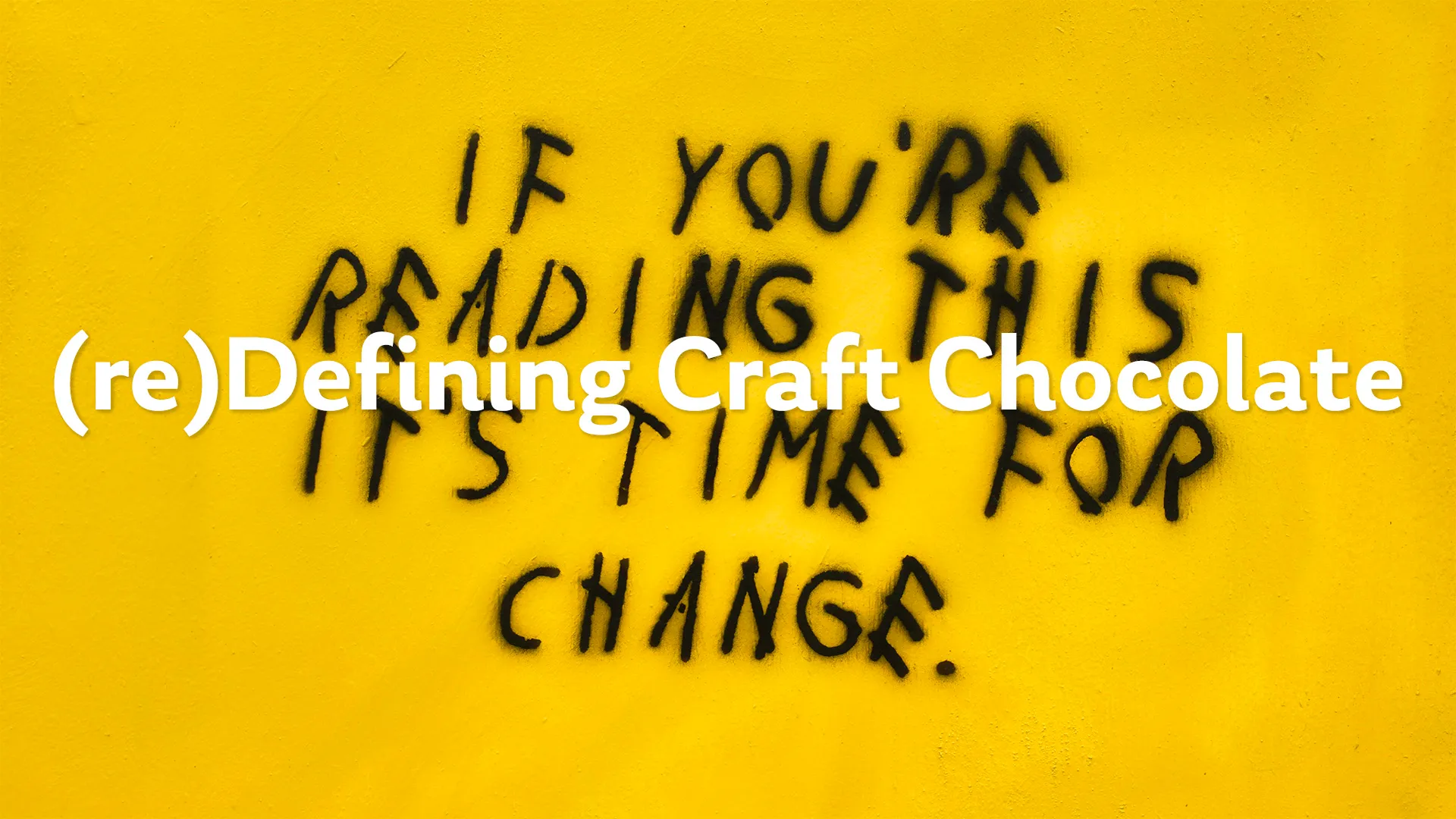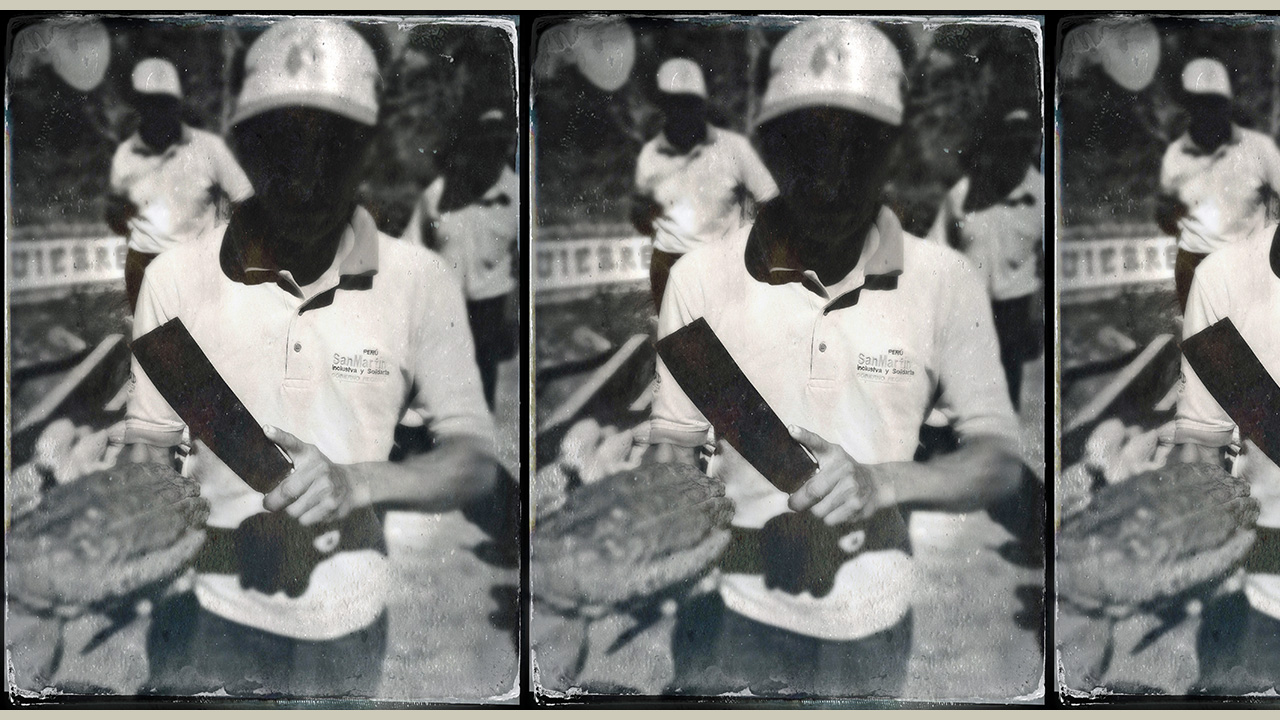TheChocolateLife::LIVE – What IS Craft Chocolate?

Episode 55 of TheChocolateLife LIVE streams on Tuesday, August 30 from 12:00 EDT. Having done a deep dive into what chocolate legally is (and isn’t) here in the US recently, it’s way past time to take a stab at what Craft Chocolate is (and isn’t).
Laying a Foundation – Why?
As I’ve discussed in other livestreams, language is important: words inform beliefs, beliefs inform actions, and actions have consequences.
More to the point of this live stream, if, as a community, we can’t come to agreement about what basic terms mean it’s no wonder potential customers are confused. Not the customers who already understand the proposition – but those who are not (yet) convinced that it’s worth paying a significant premium for so-called “craft” or “bean-to-bar” chocolate.
I use so-called here because there are no widely agreed-upon definitions for what these terms mean.
Plus, there is the case where terms the community has used from the outset of “the movement” to distinguish itself from Big Chocolate – most notably “bean-to-bar” – have been co-opted by Big Chocolate, diluting their utility and leading to more consumer confusion over the cost/value of “bean-to-bar” chocolate.
The purpose of the live stream, and this post supporting it, is to set forth, as clearly and as unambiguously as possible, what my understanding of basic terms is and how I use them, in a way that is easily communicated and understandable
My goal is to inspire discussions that will lead to consensus on their meaning.
Ethics/Ethical
— source: The Free Dictionary
What are the accepted principles of right and wrong in the professions of cocoa and chocolate? I’ve been working in cocoa and chocolate for over 25 years and I could not come up with a list I am confident in.
So I want to step back and take a 10,000 meter view and suggest the following definition:
Sustainable/Sustainability
— source: The Free Dictionary
Though I think this is a better definition than the one on ethics, I think it falls far short because of its sole focus on “the environment.” My expansion to address the perceived shortcomings is:
This definition encompasses all seventeen of the UN Sustainable Development Goals as well as embracing concepts like regenerative agriculture.
The definition is also easy to understand and easy to communicate. And, importantly for me, these definitions of are easy to mash together.
Single-Origin
A maximalist definition of single-origin means that 100% of the cocoa content (cocoa beans+any added cocoa butter/powder) used to make the chocolate come from the named place.
A minimalist definition of single-origin means just that the cocoa beans come from the named place. Some single-origin chocolates are made with beans from one country and the butter from another country. This is generally accepted as being okay.
The origin mentioned is most often a country (e.g., Brazil), though the origin can be more specific – a region/state within a country (e.g., Pará, Bahia, Espiritu Santo in Brazil), a village and its surrounding farms (e.g., Chuao in Venezuela), or a single farm/estate (e.g., Fazenda Bonança or Vale Potumuju in Bahia, Brazil).
Not all cocoa-producing countries produce sugar, and fewer still have domestic production of powdered milk, so a single-origin designation usually does not include the sugar and or milk ingredients used, nor does it necessarily apply to flavorings and inclusions. A gianduia made with beans from one country, sugar from a second country, cocoa butter from a third country, and hazelnuts from a fourth country might be labelled single-origin based on the origin of the cocoa beans alone.
Once we get past the cocoa content, for me this is a labeling issue, where the origin of the other ingredients in the bar is also called out (COOL or country of origin labeling). Not necessarily on the front but somewhere on the exterior of the packaging.
Fair Trade
Those who have followed my writing for any length of time know that I am not a huge fan of institutionalized “fair” trade. I unapologetically refer to it as “socially-acceptable economic imperialism.” It’s a bunch of white people in the global north asking a bunch of brown people in the global south to adopt values that are important to northerners – and pay for the “privilege” of doing so.
Referring back to my definition of ethical, institutionalized “fair” trade is not, in practice, ethical. It relies on there being an unequal power dynamic and unfairly taking advantage of that dynamic to benefit some entities over other.
Actual fair trade is ethical – no entity in the system is unfairly advantaged (or disadvantaged) to the benefit (or detriment) of any other. One of my criticisms is, “Who decides what’s fair?”

The structure of any ethical/fair trade system is built from the bottom up, reflecting the needs of the communities being served, not the other way around. Furthermore, certification schemes need to be more flexible and recognize that the needs of communities differ, making an inflexible one-size-fits-all framework facially unworkable (i.e., unethical).
Direct Trade
Colloquially, Direct Trade is often interpreted to mean making the supply chain as short as possible – i.e., there should be the fewest possible number of intermediaries between the farm gate and the factory receiving dock.
While that definition may address the letter of the Direct Trade concept, it falls far short, IMO, of address the essential spirit of Direct Trade. For example, with cocoa, logistics intermediaries are required t0 get it from the farm to the port of export and clear customs, to ship the cocoa to the port of import and clear customs, and then to transport it from the port to the factory or workshop. Reducing this number from (for example) five companies to two companies is not what Direct Trade is about.
Direct Trade means you’re dealing directly with the source, not through intermediaries. At its core, Direct Trade embodies developing and maintaining personal relationships with the farmers you’re buying your cocoa from. If you’ve never been to the farm, you can’t call it Direct Trade. Furthermore, because Direct Trade is about relationships, it means returning on a regular basis – eyes on, hands on, at least once a year – to, at the very least, make sure that every penny of the farm gate price promised for the cocoa gets delivered.
Bean-to-Bar
Coined and popularized in the late 1990s by John Scharffenberger and Robert Steinberg of Scharffen Berger Chocolate Maker (SBCM), the phrase “bean-to-bar” was used to differentiate what SBCM was doing compared with/to industrial/confectionery (Big Chocolate) chocolate makers.
From its very earliest usage, the phrase has accumulated a lot of baggage. Bean-to-Bar chocolate is also ethical and sustainable; bean-to-bar chocolate is made in small batches; all of the processes of bean-to-bar chocolate are performed by an artisan/craftsperson in their own workshop . This is what I think of as the maximalist definition.
The minimalist definition recognizes simply that the maker transforms cocoa beans into chocolate (bars).
In my mind there is a continuum between minimalism and maximalism, it’s not a dichotomy.
I personally tend towards minimalism and adopt the view that what’s important is personal supervision and oversight, not performing all of the steps on equipment the maker owns. I think the definition of bean-to-bar should be flexible enough to allow for a company to oversee the bean selection, cleaning, roasting and production of liquor in a producing country then shipping that liquor to their facility to finish the production of finished chocolate. However, a representative of the company must be on-site personally overseeing the in-country steps to qualify. I also don’t care about who does the wrapping as a part of the definition of bean-to-bar.
The main reason I tend to avoid the maximalist end of the continuum is that every additional concept that is added to the definition of bean-to-bar is another opportunity for someone to object to and reject that definition. If you say bean-to-bar means small batch, then you have to decide what the upper end of small batch is. Saying a maker is bean-to-bar as long as their batch size is under 35kg immediately disqualifies many hundreds of companies that consider themselves bean-to-bar.
To what end?
To what extent should a definition for bean-t0-bar chocolate be flexible to support regional/cultural differences?
Farm/Tree-to-Bar
This was the subject of some very spirited discussions during my recent trip to Brazil for the Chocolat Bahia festival, and there are maximalist (ownership) and minimalist (involvement/oversight) definitions.
After thinking about those discussions I have come to believe that the maximalist definition is the right one. To be considered Farm/Tree-to-Bar, the maker must, in fact, own the farm. As the owner, they are ultimately responsible not only for the farm and the trees, but also for the livelihoods of the people who work on the farm – wages, taxes, health and wellbeing, and more.
Someone could own a cacao farm and not be actively involved in the day-to-day activities on the farm year round. Such an owner would pay a person (or persons or company) to manage the farm on their behalf when they are absent – but the farm owner is still ultimately responsible for the employees’ wellbeing.
I don’t hold to the idea that the factory has to be located on the farm to be a Farm/Tree-to-Bar chocolate maker. The farm can be in one part of the country (say outside Itacaré or Itabuna in Bahia) and the factory/workshop in another (say in São Paulo).
Someone who owns a farm who sends their cocoa to a third-party factory for processing into chocolate is neither a farm/tree-to-bar maker, nor a bean-to-bar maker if the work of transforming the beans into chocolate is done by people other than cocoa farmer – even if the farmer’s unique recipes are followed.
If the farmer shows up at the factory with their beans and does or supervises the work themselves on equipment they don’t own, I don’t have any problem with that being called farm/tree-to-bar as long as the farmer is there for every step of every batch.
Analogy: There are many self-identified bean-to-bar chocolate companies where the processes of transforming the beans into chocolate are done by people other than the owner(s), under their direction and supervision.
And I still don’t care where the wrapping gets done. At Scharffen Berger, before they were bought by Hershey Artisan Confections, the 100gr bars were deposited and wrapped at the factory in Berkeley, The 5gr tasting squares were deposited and wrapped by a co-packer in New Jersey. Was the chocolate in the 5gr squares still bean-to-bar? IMO, yes.
Finally, What is Craft Chocolate, Then ?
Now that I have all of the above definitions out of the way, I can get to what I propose is a working definition for craft chocolate we can all agree on and rally around.
For me, after speaking with Spencer Hyman of Cocoa Runners this past June during preparation for our panel at Chocoa, and thinking about it a lot during my trips to Brazil and Colombia – it’s more valuable, IMO, to get to consensus on what craft means than bean-to-bar ... because a good definition for craft chocolate cannot be co-opted by Big Chocolate whereas bean-to-bar has already been co-opted.

Back in 2017 or so, I started positioning craft and industrial/confectionery chocolate as two ends of a continuum.
To my way of thinking, a chocolate maker became an industrial chocolate maker when consistency – day in, day out; year in, year out – became their primary concern because their customers demanded it.
For the vast majority of craft chocolate makers that level of consistency is not a concern, let alone a primary concern. Each bag of beans, each batch of chocolate, represents a new creative opportunity. So we might define craft chocolate by saying the maker is making creative decisions, a la minute, for every batch. The chocolate maker may decide that a particular batch may need a shorter or longer roasting time based on tasting a sample during the roast; and/or they may decide that a batch needs more or less time in the refiner and/or in the conche because ... it does, in their opinion. While there is a recipe, it can be altered, in real time, as needed, based on the creative intent, the aesthetic, the mood, of the maker.
Because craft and industrial are on a continuum, there are maximalist and minimalist aspects to this definition. A craft chocolate maker might use, for example, an instrumented roaster with thermocouples connected to a computer and a PLC not just for monitoring the roast, but to actually control the roaster in real time. Does this make them an industrial chocolate maker? That depends entirely on how they use the roaster in practice.
Another way to approach this, and probably the better way, is to say that craft chocolate makers are looking to express a flavor potential they see in the beans. This flavor potential is based on their assessment of the beans and what they are looking to achieve, and that this unfettered expression is paramount. On the other hand, Industrial/confectionery chocolate makers, focus on delivering chocolate with a particular specific flavor, rheology, pH – manipulating the chemistry and physics of the process to take ingredients that may differ in flavor and other metrics from container to container or harvest to harvest in order to achieve a pre-defined, consistent, result.
Should a definition for craft chocolate include or revolve around the notion of craftsperson/artisan?
Does craft automagically mean good? Are they synonymous?

In Closing
You’ll notice, in my definition of craft, that there is no discussion of what kind of equipment is used. Nor is there a discussion of batch size or a ceiling on the total amount of cocoa processed/chocolate made in a year.
None of these is central to a successful definition of craft. These are baggage, and they distract from what craft chocolate is truly about – flavor. Having an arbitrary cut off of (say) 100MT; above 100MT of cocoa processed you are no longer a craft chocolate maker makes no sense. What happens if a company processes 104MT? Does that disqualify them? (Of course not.) Suggesting that “real”craft chocolate maker can only be done in stone refiners is likewise misguided.
Craft chocolate is about flavor – the intent with which you use tools at hand, why and how, is what matters, not whether they are metal-on-metal and not stone-on-stone, or below 100kg/batch or hour or day. Arguing about these distinctions is a distraction to what really matters – flavor.
Finally, when labeling and marketing craft chocolate, makers should, IMO, de-emphasize single-origin at the country level, instead switch to using geographic descriptors that get them as close to the farm – and the farmers – as possible. This is something craft chocolate makers can do easily, and that is harder for Big Chocolate to do.
Other Resources

I disagree with more than 50% of the assertions in the opening paragraphs of the Wikipedia entry. Bean-to-bar:
- Is NOT a trade model.
- Is NOT a legal labeling concept.
- Is NOT clearly defined as a consistent manufacturing process.
- Is NOT a term that has become synonymous with craft, fine, high-quality, natural, and nutritional chocolate.
- Did NOT emerge from the artisan and craft chocolate movement around 2010 (more likely the late ’90s, which the article implies further down).
Live Stream Links
Watch/Participate on YouTube, Facebook, or LinkedIn.
Visit TheChocolateWire Channel on YouTubeMy LinkedIn profile
TheChocolateLife page on Facebook
Leave them in the comments.


